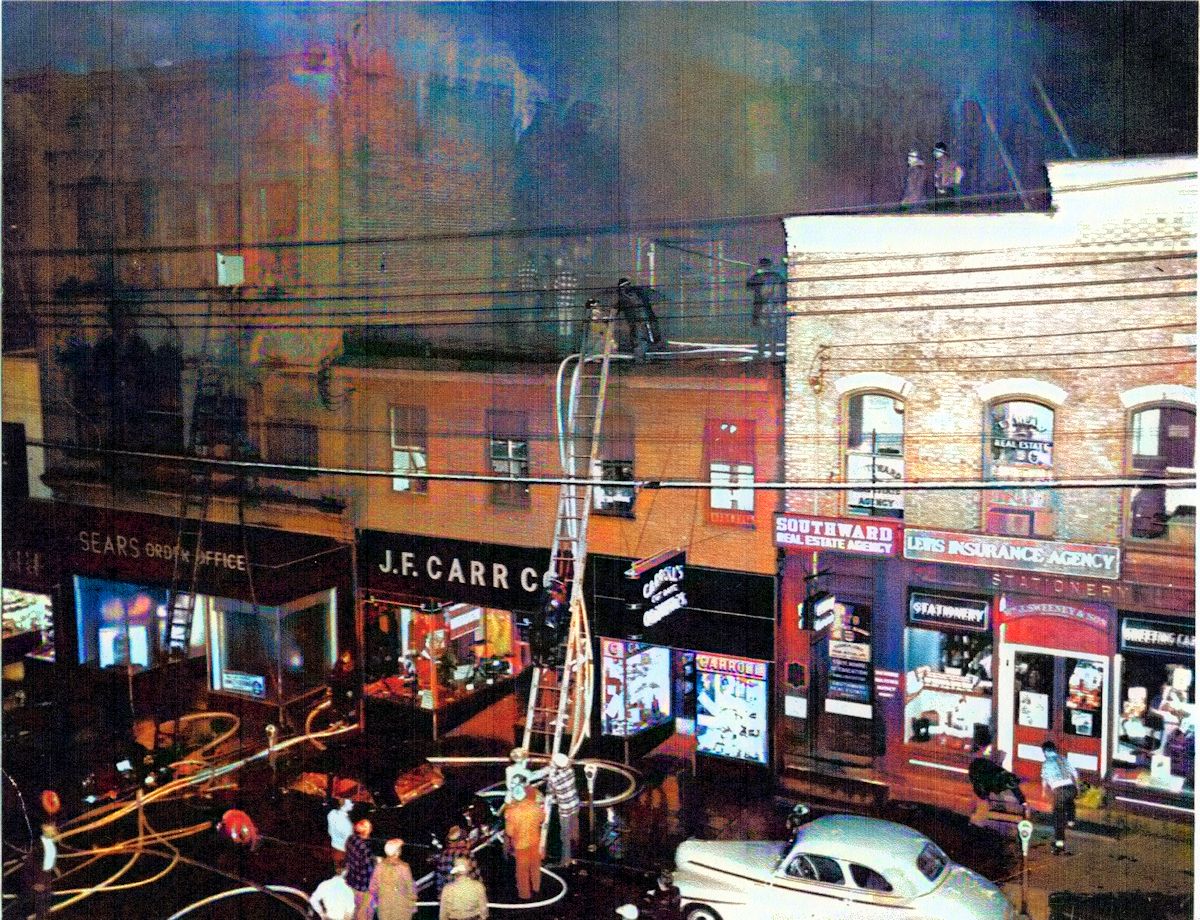by Pete Zizka
2-24-2024

Click on photo for larger version
|
Dennis Shea - Part 2 by Pete Zizka 2-24-2024 |
After losing a trial in which the city claimed
that his building was in violation of an ordinance, entrepreneur Dennis
Shea quickly appealed to the Superior Court. Shea had been represented
by his son, James A. Shea. James had been admitted to the bar in
November, 1902 and by January, 1903 was appointed to the Probate Court
and a month later was named Deputy Judge of the Police Court. In the
Superior Court trial, the case was nolled and Shea then completed his
building. (Many people will remember that in the 50s and 60s, Shea’s new
building was home to Terry’s Kiddie Shop while Hallocks Restaurant was
in the building next door.) It wasn’t long after winning his case that
Shea was once again embroiled in a controversy with yet another of his
buildings on Main Street. In January, 1907, Shea decided to put an
addition on his building at 766 Main Street in order to increase the
floor space of the stores. The addition was proposed to run from the
rear of his building to the railroad’s property. To do so, he found that
he would need to use the entire width of his property. A problem
appeared since the adjoining property, the Sadd Block, was partly on
Shea’s property – a mere six inches in front but three feet in the back.
Sadd had been paying Shea $40 a month for rent. But now, Shea demanded
that Sadd move his building so that the Shea could proceed with his
addition. Six months after Shea served notice, Sadd had done nothing and
Shea was getting anxious to have his property cleared. Sadd noted that
in order to comply, he would lose one tenant and cut off a corner of the
building which, at that time, was occupied by the Remington Company. The
corner of a barn belonging to another person would also have to have a
corner cut off. Sadd eventually began the work of building a new wall
for the west side of his building. Excavations for the wall had been
made and the project had come to a point where Sadd was ready to take
down the portion of the wall that extended onto Shea’s property. But,
now a situation was found that would allow Sadd to take the “legal
proceedings” into his own hands. It was found that while the Sadd
building was on Shea property above ground, the Shea building was
on Sadd’s property underground anywhere from four to eighteen
inches. And so Sadd now hired a lawyer to serve notice on Shea that he
(Shea) needed to move his building from Sadd’s property underground.
Sadd listed twenty witnesses who had seen the evidence and said he was
ready to start proceedings against Shea. Shea responded that he would
move the underground wall if it was shown that it was on Sadd’s
property. The outcome was that the suits were settled amicably and Sadd
replaced a frame wall with a new masonry wall on the rear west portion
of his building. Interestingly, what was, even into the 1960s, referred
to as “The Sadd Block” was actually owned by Sadd’s father-in-law,
Leander Freeman. After being
engaged in several joint ventures, Truman R. Sadd joined with Freeman in
a joint stock business with Mr. Freeman as President. Sadd conducted the
business until 1914 when the building was sold to the F.W. Woolworth
Company and 760 became home to the “Five and Ten’s” first Willimantic
location. Dennis Shea, in the meantime, had acquired another saloon and
was still referred to as one of the wealthiest men in the city. In 1912,
he moved his family back to Willlimantic after purchasing what was known
as “The John M. Hall estate” at 125 Windham Road. Hall had been the
president of the New York, New Haven and Hartford Railroad and became a
judge on the states Superior Court. The residence was considered to be
“one of the finest in the city…It is a beautiful building with excellent
surroundings”. Dennis Shea had come to Willimantic in 1854 after serving
in the Navy during the Civil War. He died in his Windham Road mansion in
1930. At his funeral Mass in Saint Joseph’s Church, his casket was
draped with the American Flag and his pallbearers were the city’s
leading Irishmen. Today’s photo was taken during a 1949 fire in the Sadd
Block (left, occupied at that time by Sears and the J.F. Carr Company).
The fire ruined the third floor of the Sadd Block, caused water damage
to second floor apartments, and affected the first floor businesses The
Shea building is on the right and was occupied by Southward Real Estate,
Lewis Insurance and, on the ground floor, Sweeney’s Stationery).
 Click on photo for larger version |
| <<HOME>> <<back to Historical Articles index>> |